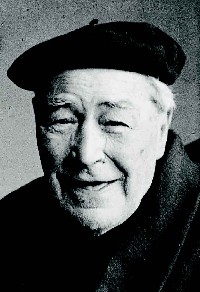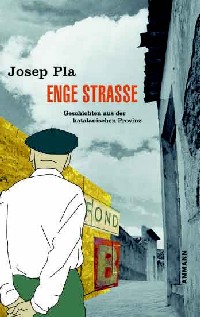

PLA, Josep (Palafrugell, Baix Empord�, 1897 � Llofriu, 1981)

Escriptor. De precoç vocació, el 1918 s’iniciava com a periodista professional, a Las Noticias, i poc després -i fins acabada la Guerra Civil espanyola- com a corresponsal a La Veu de Catalunya, gràcies a la qual viatja a França, Itàlia, Anglaterra, Alemanya o la URSS. D’aquesta etapa són els llibres Rússia (1925), Cartes de lluny (1928), Francesc Cambó (1928-30), Madrid (L’adveniment de la República) o Viatge per Catalunya (1934) que demostren la varietat temàtica que continuaria tractant: narració pura, llibres de viatges, biografies i cròniques periodístiques. A partir de 1939 s’instal·la definitivament al seu entorn natal, l’Empordà, que serà clau en la seva obra i d’on pràcticament no es mourà. A partir de 1947, començà a publicar els llibres en català i inicià l’etapa més fecunda. Publicà Cadaqués (1949), El carrer estret (Premi Joanot Martorell 1952), Nocturn de primavera, Peix fregit o Week-end d’estiu a New-York (1956), entre molts altres. Aquell any del 56 signava un acord amb Destino per publicar els 45 volums que seran les seves Obres completes i que començaran el 1966 amb El quadern gris, una de les peces autobiogràfiques més considerables de la literatura catalana, escrit entre el 1918-19. Amb una escriptura d’una riquesa imaginativa verbal extraordinària; la crítica social i el retrat psicològic i l’admiració pels memorialistes, la seva obra es pot considerar com unes vastes memòries que cobreixen mig segle de vida catalana i que l’han convertit en l’escriptor més popular i, segurament, més llegit.
Schriftsteller. Schon sehr früh, nämlich 1918, begann er sich seiner Berufung, dem Journalismus, in Las Noticias zu widmen; wenig später - und bis zum Ende des spanischen Bürgerkrieges - war er Korrespondent von La Veu de Catalunya, was ihm erlaubte Reisen nach Frankreich, Italien, England, Deutschland und die UdSSR zu machen. Aus dieser Lebensphase stammen die Bücher Russland (1925), Briefe aus der Ferne (1928), Francesc Cambó (1928-30), Madrid (Das Entstehen der Republik) und Reise durch Katalonien (1934), was eine Themenvielfalt zeigt, die er auch anschließend beibehielt: reine Erzählungen, Reisebeschreibungen, Biografien und journalistische Chroniken. 1939 siedelte er sich endgültig in seiner Geburtsregion, dem Empordà, an, einer Region, die eine Schlüsselposition in seinem Werk einnimmt und aus der er sich praktisch nicht mehr weg bewegte. 1947 begann er seine Bücher auf Katalanisch zu veröffentlichen, es fing seine schaffensreichste Phase an. Cadaqués (1949), Die enge Straße (Joanot-Martorell-Preis von 1952), Frühlingsnacht, Gebratener Fisch oder Sommerwochenende in New York (1956) sind einige davon. 1956 unterzeichnete er ein Abkommen mit dem Verlag Destino um die 45 Bände seiner gesammelten Werke herauszubringen, die 1966 mit dem Grauen Heft begonnen wurden, einem der bedeutendsten autobiografischen Texte der katalanischen Literatur entstanden zwischen 1918 und 1919. Von außerordentlich phantasievoller Ausdrucksweise, sozialkritisch, voll psychologischer Portraits und Anerkennung für die Verfasser von Memoiren, kann sein Werk als die ein halbes Jahrhundert umfassende Chronik des Lebens in Katalonien angesehen werden. Pla ist der beliebteste und sicher am meisten gelesene Autor Kataloniens.
Writer. Josep Pla was an early starter: in 1918 he began as a professional reporter with Las Noticias, and a short while after - with the end of the Spanish Civil War - as a correspondent with La Veu de Catalunya, thanks to which he visited France, Italy, English, Germany and the then-USSR. From this period came the books Russia (1925), Letters from Afar (1928), Francesc Cambó (1928-30), Madrid (The Rise of the Republic) and Journey through Catalunya (1934) which demonstrate the thematic variety that he would continue to handle: pure narrative, travel books, biographies and feature articles. Starting in 1939, Pla settled definitively in his native region, l’Empordà, which would be key for his work and from where after he practically would not move. From 1947 he began to publish his books in Catalan, starting his most fertile period. He published Spring Nocturne, Fried Fish and Summer Weekend in New York (1956), among many others. In that same year of 1956 he signed an agreement with Destino to publish the 45 volumes that would be his Complete Works, which would begin in 1966 with his Gray Notebook, one of the highest esteemed works of autobiography in Catalan Literature, written between 1918-1919. With a verbal writing style of extraordinary imaginative richness, full of social criticism, psychological portraiture and an admiration for memoirists, his work can be considered vast memoirs that cover a half-century of Catalan life, and that have converted Pla into the most popular and, surely, the most widely read of writers.
Selected works in translation
- Dutch Het Grijze schrift De Arbeiderpers, 1993
- French Le cahier gris: un journal Jacqueline Chambon, 1992
- Italian L’Isola di Sardegna La Celere,1990
- German
- Das graue Heft Suhrkamp, 2007
- Gaudí Berenberg, 2007
- Der Untergang der Cala Galiota Berenberg, 2007
- Spanish
- El cuaderno gris: un dietario Destino, 1997
- Lo que hemos comido, pref. M.V. Montalbán Destino, 1997
- La Segunda República Española: una crónica, 1931-1936 Destino, 2006
- Nocturno de primavera Destino, 2006
- Serbian Sivi Dnevnik Alexandria-Press, 2006




